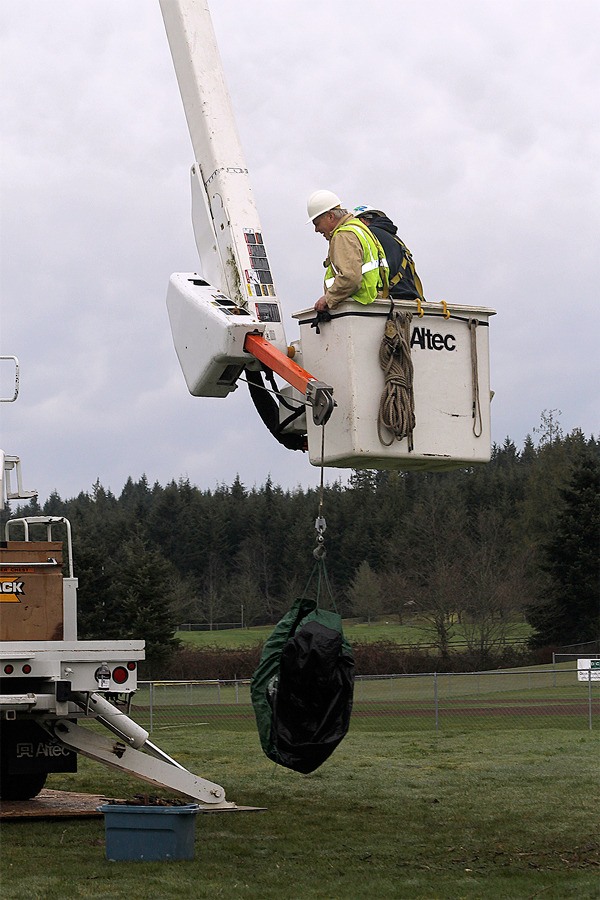A new nesting space is awaiting the resident osprey of Waterman’s Field at South Whidbey High School.
The birds of prey are expected to return from their southern migration in the next couple of weeks. Workers installed a new nest platform and post this week, replacing the osprey’s previous nest which weighed approximately 400 pounds and had caused the light pole upon which it was situated to bend.
The new space is located in the same general area, slightly south of the field.
The South Whidbey School District worked with the Whidbey Audubon Society, Puget Sound Energy and Osprey Solutions to relocate the birds’ nesting space. The post installation cost of $3,000 was funded by Puget Sound Energy; the Whidbey Audubon Society donated $600 for the new platform; and the school district covered the remaining $3,100.
Osprey had first settled into their digs at South Whidbey High School over 15 years ago, and had continued adding materials to the nest year after year. In its previous location, it was potentially dangerous to both birds and humans.
Droppings of twigs and bird feces from the nest presented potential hazards to passersby, and the structural integrity of the pole was compromised by the nest’s size and weight.
There was also a potential risk of the nest igniting from the heat of the field lights, which could wound or kill the birds.
Brian Miller, director of facilities and maintenance for the school district, consulted with the Seattle-based environmental consulting firm Osprey Solutions late in 2014, and presented the idea to the school board in December.
The company, headed by raptor biologist Jim Kaiser, provided the school district with a new, sturdy nest platform and new post.
Kaiser also assisted Miller and Puget Sound Energy with the installation this week, and ensured that the new platform and post will be inviting to the birds upon their homecoming. In order to encourage the birds to rebuild their nest, Kaiser placed materials from the previous nest onto the platform.
Members of the Whidbey Audubon Society also attended the new nest installation, and commended the efforts of all parties.
“What a nice project to be a part of,” commented Anna Swartz, a Whidbey Audubon member.
Mel Walters, head of the Puget Sound Energy Avian Protection Program, said the company has successfully completed about 60 similar projects statewide.
It is a move that is as beneficial for the birds as it is for the company and residents, he said, as safe relocation lowers the risk of power outages or hazards.
“We’re used to doing power lines, but we do birds’ nests too,” said Puget Sound Energy foreman Todd Proudlock, joking that it was a relatively stress-free day for the crew.
The workers began at around 7:30 a.m. Thursday and continued working through Friday morning.
Kaiser noted that osprey have been nesting upon man-made structures since 1905, when they made their home atop a telegraph pole, prompting area residents to provide them with a platform fashioned from a wagon wheel to prevent the pole from toppling.
The nest platform provided by Osprey Solutions is composed of lightweight, high-strength aluminum alloy supported by a frame of angle aluminum. The bottom is made of a lattice of plastic and a four-inch plastic border. A cedar perch, situated downwind and parallel to the nest area, provides a safe place for the mature osprey to guard their nestlings from aerial predators. An anti-predator guard is situated on the pole about 10 feet off the ground in order to prevent ground predators from climbing to the nest.
“We’re optimistic that it’ll go well and the birds will like their new home, and their new view,” said Miller.
Miller and others will inspect the nest periodically to remove any materials that may harm the birds, such as fishing wire.
In order to prevent osprey or other birds from nesting on any of the light poles in the future, the crew installed nest inhibitors.
According to Miller and Swartz, students at the high school are enthused at the idea of eventually procuring a web camera to situate on the post near the nest, in order to learn more about the bird’s behavior.
The district and Whidbey Audubon Society have been unable to purchase one as of yet, but will accept a donation if anyone in the community would like to contribute.



